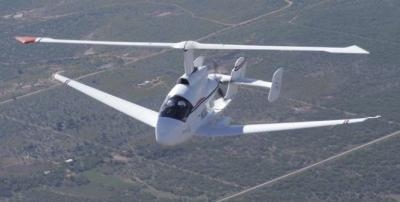Fri, Dec 21, 2012
Four-Place VTOL POC Aircraft Continuing Test Flights
Carter Aviation Technologies ... working in conjunction with Carter Aerospace Development ... says it has made significant progress as performance flight-testing of its current Slowed-Rotor/Compound (SR/C) prototype, the Proof of Concept demonstrator (the “POC”), continues. The POC is a variant of the company’s four passenger vertical takeoff and landing (VTOL) aircraft, known as the 4-Place PAV.

According to the company, the POC is continuing to expand the high speed/slowed rotor envelope. During performance flight-testing in November, the aircraft flew with the rotor slowed to 106 rpm. The company says that by significantly slowing the rotor rpm to less than half that of a comparably-sized helicopter, the aircraft demonstrated a lift-to-drag (“L/D”) value of 12 – around two-and-a-half times better than the most efficient helicopters.
L/D is a measure of the efficiency of an aircraft (lift or weight divided by drag or thrust). Higher L/D ratios are directly related to enhanced speed, fuel economy, climb performance, and glide ratio.
The flight also resulted in an advance ratio of 0.85. The advance ratio is calculated by dividing the forward airspeed of the aircraft by the tip speed of the rotor. As the rotor rpm (i.e., the tip speed) is reduced, the advance ratio increases. As the advance ratio increases, drag on the rotor decreases dramatically, resulting in increased efficiency.
Carter Aviation Technologies says that these key achievements clear the way for the POC to achieve speeds in excess of 200 knots at 25,000 feet and 350 HP with the current test weight of 3,950 lbs. Additionally, the POC has proven its VTOL capability, achieved speeds in excess of 140 knots on 200 HP and an altitude of 12,000 feet.
The company will continue to expand the high speed/slowed rotor envelope at ever-increasing altitudes, and will gather more data on flight efficiencies under those conditions.
(Photo provided by Carter Aviation Technologies)
More News
Airport Marking Aids Markings used on runway and taxiway surfaces to identify a specific runway, a runway threshold, a centerline, a hold line, etc. A runway should be marked in ac>[...]
"It is extremely difficult, if not impossible, for manned aircraft to see a drone while conducting crop-enhancing and other aerial applications at low altitudes and high speeds. We>[...]
Aero Linx: The Skyhawk Association The Skyhawk Association is a non-profit organization founded by former Skyhawk Pilots which is open to anyone with an affinity for the A-4 Skyhaw>[...]
“The T-54A benefits from an active Beechcraft King Air assembly line in Wichita, Kansas, where all required METS avionics and interior modifications are installed on the line>[...]
Aero Linx: Aerostar Owners Association The Association offers the Aerostar Owner a unique opportunity to tap an invaluable source of information concerning the care and feeding of >[...]
 ANN's Daily Aero-Term (04.28.24): Airport Marking Aids
ANN's Daily Aero-Term (04.28.24): Airport Marking Aids Aero-News: Quote of the Day (04.28.24)
Aero-News: Quote of the Day (04.28.24) ANN's Daily Aero-Linx (04.28.24)
ANN's Daily Aero-Linx (04.28.24) Aero-News: Quote of the Day (04.29.24)
Aero-News: Quote of the Day (04.29.24) ANN's Daily Aero-Linx (04.29.24)
ANN's Daily Aero-Linx (04.29.24)



